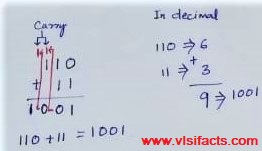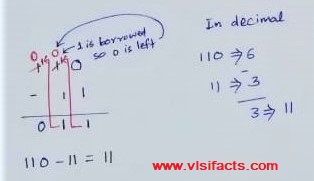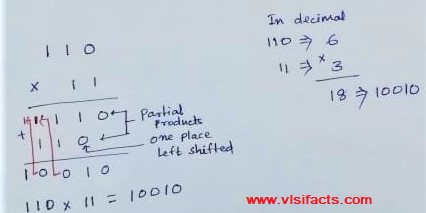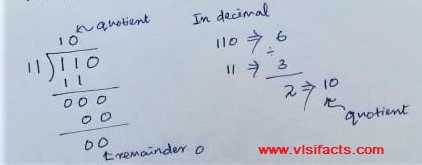Binary arithmetic is essential in all digital computers and in many other types of digital systems. Now, since we know about different number systems and signed numbers, this is the right time to learn about binary arithmetic and the associated rules.
First, we would learn about the basic rules of binary arithmetic, and solve some examples for unsigned magnitude numbers. Later, we will solve more examples for signed binary numbers (very much important from the exam point of view).
Binary Addition
The basic rules of binary addition are as below:
- 0 + 0 = 0 Sum of 0 with a carry of 0
- 0 + 1 = 1 Sum of 1 with a carry of 0
- 1 + 0 = 1 Sum of 1 with a carry of 0
- 1 + 1 = 0 Sum of 0 with a carry of 1
Example: Perform the binary addition of 110 + 11.
Solution:
Binary Subtraction
The basic rules of binary subtraction are as below:
- 0 – 0 = 0
- 1 – 1 = 0
- 1 – 0 = 1
- 10 – 1 = 1 0 – 1 with a borrow of 1
In binary, whenever a ‘1’ is subtracted from a ‘0’, then a ‘1′ is borrowed from the next column to the left.
Example: Perform the binary subtraction of 110 – 11.
Solution:
Binary Multiplication
The basic rules of binary multiplication are as below:
- 0 × 0 = 0
- 0 × 1 = 0
- 1 × 0 = 0
- 1 × 1 = 1
Multiplication in the case of binary numbers is similar to decimal multiplications. The partial products are computed, and each successive partial product is shifted by one place left and then added to get the final multiplication result.
Example: Perform the binary subtraction of 110 × 11.
Solution:
Binary Division
The process of division is exactly the same as decimal division. We can realize the same from the following example.
Example: Perform the binary division of 110 ÷ 11.
Solution:
The binary arithmetic, which we discussed till now, is for unsigned magnitude numbers that deal with only positive numbers. However, computers deal with signed numbers (both positive and negative numbers). 2’s complement form for representing signed numbers is the most widely used in computer and microprocessor-based systems. So, we would first cover the 2’s complement arithmetic. We will primarily discuss the addition operation. Subtraction operation can be seen as the addition of negative numbers (check the “Addition” article). Multiplication and Division can be thought of as repeated addition and repeated subtraction, respectively. However, if you want separate articles for 2’s complement multiplication and division, then please mention it in the comment section.
Also, read Arithmetic of 1’s complement signed binary numbers. But, I would again emphasize that computers use 2’s complement notations. Additionally, go through the rules of hexadecimal arithmetic.



